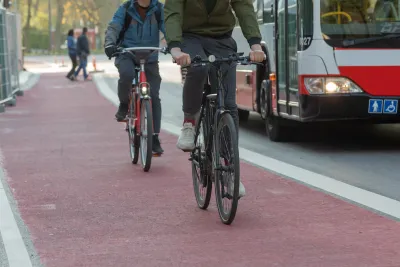An explainer from Momentum highlights the advantages of reducing vehicle lanes in favor of more bike, transit, and pedestrian infrastructure.

An explainer from Momentum Magazine outlines the benefits of road diets, a popular but controversial traffic calming strategy that focuses on reducing the number of vehicle lanes and adding sidewalks and other bike and pedestrian infrastructure to streets.
According to author Ron Johnson, “ The first road diet in the United States was implemented in 1979 in Billings, Montana. Since then, cities like Charlotte, Chicago, San Francisco, and New York have all embraced the model. But it’s not just a design trend—road diets are backed by powerful data and safety results.”
Reducing the number of lanes and average speeds can cut crashes by as much as 52 percent, and slower speeds also mean crashes can be less serious when they do occur.
Although road diet opponents worry about traffic, “Removing travel lanes can actually lead to a reduction in overall vehicle trips—a phenomenon known as traffic evaporation. Some drivers shift to alternative routes or, increasingly, to alternative modes of transport.” Better bike and pedestrian infrastructure incentivizes more people to use those modes, and bus lanes make transit a more reliable option. Road diets thus also lead to reduced carbon emissions and cleaner air.
“As our cities continue to evolve, road diets offer a cost-effective, data-backed, and scalable way to make them safer, cleaner, and more livable,” Johnson concludes.
FULL STORY: Explainer: What Is a Road Diet—And Why Should Cities Embrace It?

Alabama: Trump Terminates Settlements for Black Communities Harmed By Raw Sewage
Trump deemed the landmark civil rights agreement “illegal DEI and environmental justice policy.”

Planetizen Federal Action Tracker
A weekly monitor of how Trump’s orders and actions are impacting planners and planning in America.

The 120 Year Old Tiny Home Villages That Sheltered San Francisco’s Earthquake Refugees
More than a century ago, San Francisco mobilized to house thousands of residents displaced by the 1906 earthquake. Could their strategy offer a model for the present?

In Both Crashes and Crime, Public Transportation is Far Safer than Driving
Contrary to popular assumptions, public transportation has far lower crash and crime rates than automobile travel. For safer communities, improve and encourage transit travel.

Report: Zoning Reforms Should Complement Nashville’s Ambitious Transit Plan
Without reform, restrictive zoning codes will limit the impact of the city’s planned transit expansion and could exclude some of the residents who depend on transit the most.

Judge Orders Release of Frozen IRA, IIJA Funding
The decision is a victory for environmental groups who charged that freezing funds for critical infrastructure and disaster response programs caused “real and irreparable harm” to communities.
Urban Design for Planners 1: Software Tools
This six-course series explores essential urban design concepts using open source software and equips planners with the tools they need to participate fully in the urban design process.
Planning for Universal Design
Learn the tools for implementing Universal Design in planning regulations.
Clanton & Associates, Inc.
Jessamine County Fiscal Court
Institute for Housing and Urban Development Studies (IHS)
City of Grandview
Harvard GSD Executive Education
Toledo-Lucas County Plan Commissions
Salt Lake City
NYU Wagner Graduate School of Public Service





























